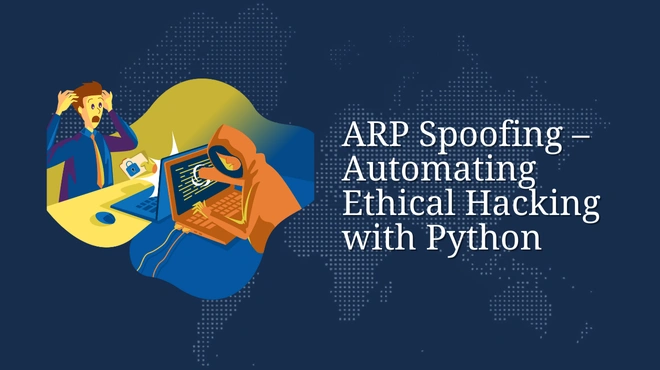
ARP Spoofing – Automating Ethical Hacking with Python
Master ARP Spoofing with Python & Scapy: Learn ARP Poisoning Mechanics, Ethical Hacking Defenses, and Enterprise-Grade Mitigation Strategies
Stop being a generalist. Get the definitive, advanced credential that validates your mastery of the entire AWS automation stack, unlocking the high-stakes SRE and Platform Architect roles.
You're stuck in a loop of manual deployments, broken testing environments, and endless patching cycles. You may be called a DevOps Engineer, but your actual work is 70% firefighting and 30% scripting. Meanwhile, the AWS Certified DevOps Engineer - Professional defines the entire pipeline strategy, automates security and compliance, and commands 35-50% higher compensation because they eliminate the chaos you are currently managing. Your lack of a verifiable, professional-level DevOps Engineer certification is the gatekeeping filter preventing you from moving into strategic SRE and architecture roles. This isn't another generic "introduction to DevOps" course that vaguely covers Git and Docker. Our DevOps Engineer course is designed by active, principal-level SREs and DevOps consultants who have implemented large-scale, automated systems for demanding Houston, TXFinTech, E-commerce, and SaaS companies facing millions of transactions daily. They've built this training to teach you not just the tools, but the architecture and process philosophy required to achieve true Continuous Delivery and Operational Excellence. You will move past merely setting up pipelines to designing solutions for business-critical stability and cost control. This means mastering infrastructure as code (IaC) with CloudFormation/Terraform to achieve immutable infrastructure, implementing zero-downtime Blue/Green and Canary deployments, and establishing automated guardrails for security and compliance (DevSecOps). The exam is the professional check - the real value is the ability to walk into any major IT firm in Houston, TX and immediately architect a production-grade CI/CD solution that cuts release time from weeks to hours. We've structured this for the senior working professional who can't afford failure. Intensive evening and weekend live batches are mandatory. You get access to a fully-configured, professional-grade lab environment, advanced deployment templates used in major Houston, TXservices companies, 24/7 expert support, and a hyper-focused methodology to crack the complex DevOps Engineer interview questions and AWS Certified DevOps Engineer - Professional exam.
Focuses exclusively on the complex, integrated knowledge required for the AWS DOP-C02 Professional certification.
Learn deployment, monitoring, and automation strategy directly from certified, battle-tested AWS Professional Engineers.
50+ hours of mandatory, scenario-based labs focusing on multi-region, highly-available pipeline design and troubleshooting.
Deep dives into integrating Source Control (Git), CI/CD Orchestration (CodePipeline/Jenkins), and IaC (CloudFormation/Terraform).
Access to 1200+ complex, multi-choice scenario questions and 10+ full-length mock exams to build professional-grade stamina.
Immediate, authoritative guidance from certified professionals on your toughest IaC, deployment, and troubleshooting challenges.

Get a custom quote for your organization's training needs.
Master the AWS Code Suite (CodeCommit, CodeBuild, CodePipeline, CodeDeploy) to design automated, auditable, and resilient multi-stage delivery systems.
Learn to implement Infrastructure as Code (IaC) with CloudFormation for predictable, repeatable deployments, eliminating configuration drift and manual errors.
Design and implement cross-region and multi-AZ deployments for fault tolerance, using Auto Scaling groups with advanced healing and rollback policies.
Implement automated security controls using IAM Roles, Federation (SAML/Cognito), and encryption to protect data in transit and at rest across all AWS services.
Master the configuration of Highly Available (HA) and Scalable databases using Amazon RDS (Multi-AZ, Read Replicas) and architecting with DynamoDB.
Implement and enforce IT governance policies using AWS Config, CloudTrail, and CloudWatch to ensure continuous compliance and monitor performance.
If your role requires you to design, deploy, and manage highly resilient, compliant, and automated AWS solutions at scale, and you have 2+ years of hands-on experience with AWS environments, this program is your mandatory path to strategic recognition.


Stop getting filtered out for senior SRE and Platform Architect roles that explicitly demand this level of certified expertise.
Unlock the highest salary bands reserved for engineers who can confidently automate and manage business-critical, multi-million dollar AWS workloads.
Validate complex, integrated skills across the entire software development lifecycle (SDLC) on AWS, proving your strategic value over tactical knowledge.
The DOP-C02 is an expert-level exam. AWS sets a clear benchmark to ensure every certified professional has a proven track record.
Recommended Experience: 2 or more years of experience provisioning, operating, and managing AWS environments, including deep experience with continuous delivery and IaC.
Associate Certification (Recommended): While not mandatory, holding the AWS Certified Developer Associate or SysOps Administrator Associate is strongly advised.
The reality: If you cannot confidently use CloudFormation, design a multi-AZ VPC, or secure an S3 bucket with IAM policies without looking it up, this exam will crush you. This program provides the necessary depth to meet these prerequisites.
Mastering YAML/JSON templates, Intrinsic Functions, Parameters, Mappings, and Outputs. Implementing complex logic with Conditions and Pseudo Parameters.
Mastering Nested Stacks for modularity, utilizing Custom Resources for unsupported services, and advanced use of DependsOn for resource ordering.
Systematic approach to troubleshooting failed stacks (Rollback failure, drift detection). Implementing best practices for template security and reusability across accounts.
Working with Docker images and registries (ECR). Deploying and managing containerized applications using ECS Fargate/EC2 launch types.
Mastering Elastic Beanstalk environments for simple, repeatable application deployment. Configuring environments, application versions, and health checks.
Replacing old tools (OpsWorks) with modern services like AWS Systems Manager (SSM) for patch management, configuration drift correction, and run command automation.
Understanding the difference between elasticity and scalability. Implementing disposable resources and architecting with services instead of stateful servers.
Mastering Auto Scaling Group (ASG) lifecycle hooks for pre- and post-instance actions. Creating and testing self-healing ASGs that automatically replace failed instances.
Designing highly available architectures using Multi-AZ deployments, Cross-Region Replication, and Global Services (Route 53, Global Accelerator).
Mastering Amazon RDS (Multi-AZ, Read Replicas) for relational databases. Understanding and leveraging Amazon Aurora for performance and resilience.
Getting started with DynamoDB. Mastering Provisioned Throughput, Global Tables, and Secondary Indexes for highly scalable NoSQL applications.
Deep-dive into IAM Roles and Policies. Implementing Cross-Account Access for resource delegation, and utilizing SAML and Cognito for corporate and web identity federation.

Our experts are ready to help you with any questions about courses, admissions, or career paths. Get personalized guidance from industry professionals.
"PMI®", "PMBOK®", "PMP®", "CAPM®" and "PMI-ACP®" are registered marks of the Project Management Institute, Inc. | "CSM", "CST" are Registered Trade Marks of The Scrum Alliance, USA. | COBIT® is a trademark of ISACA® registered in the United States and other countries. | CBAP® and IIBA® are registered trademarks of International Institute of Business Analysis™.


